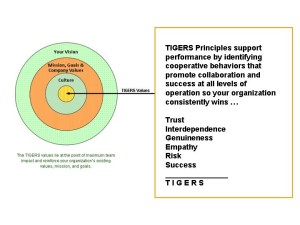
Are rumors and vicious gossip dominating employee conversations?
Is productivity all but non-existent?
Then your workplace culture could be suffering from lack of employee trust. So what is trust and what team building activities will improve it?
Trust…is the foundation. TIGERS builds strong workplace cultures upon and the cornerstone for collaborative and cooperative teamwork.
What exactly is trust?
In the Merriam-Webster dictionary, the definition is “having assured reliance on the character, ability, strength, or truth of someone or something.” It’s a simple, straightforward definition by any account, yet trust is so elusive…especially in the workplace where employees are actively disengaging every day.
According to “Building Trust in Business,” an annual survey conducted by Boston-based Interaction Associates, trust in the workplace has declined every year (with the exception of a virtually stagnant 2013) since the 2008 financial collapse began.
Why?
One reason is that the recent recession made budget cuts, layoffs, and stagnant or reduced wages the norm. Employees saw workloads double, but received no extra compensation or consideration…besides a condescending retort: “At least you have a job.” Swift layoffs and cutbacks with little or no employee notice lead to a significant loss of faith in management. As employees competed against each other for positions, trust and teamwork among fellow coworkers eroded as well.
Fast forward to today’s economic climate and many employers are now finding they have a mistrusting and suspicious workforce on their hands. But let’s not blame everything on the recent recession…that’s just too easy and convenient. Let’s look at warning signs and other underlying trust factors that have been festering under the corporate skin for years….
1. Sluggish Engagement
Just like trust….let’s answer this question as well: what is employee engagement?
“It’s an employee’s level of involvement, emotional commitment, satisfaction with their job, and satisfaction with the organization’s goals and visions.” Employees experiencing “sluggish” engagement are in the process of disengaging or have already disengaged at work. Emotional commitment and job satisfaction have waned considerably with the continual upheaval and uncertainty in today’s workplace.
Here are the warning signs of sluggish engagement:
- Low morale can be caused by a number factors including lack of proper training for success on the job, unethical behaviors on the part of management teams, or employees who undermine a coworker’s contribution. A disgruntled employee with little trust in his company is not the employee you want dealing with customers, partners, and vendors.
- Low productivity levels – More times than not, low productivity stems from lack of communication between employees, departments, and management. Employees are left in the dark to second-guess directives. Another reason for low productivity is that an employee does not feel challenged or stimulated in his current position and will just perform the minimum to get by.
- Incivility – Incivility has increased in the workplace over the past decade putting undue mental and physical stress on employees. Low tolerances for diversity and disrespect of a coworker’s opinions, differences, creativity, and thought processes has made for a hostile work environment. Many organizations do not have policies in place to deal with incivility or simply ignore it.
- High turnover rates – What does low morale, low productivity and incivility equal? Higher turnover rates. Top talent will always leave for greener pastures to seek out an organization that embraces an employee-centric environment. Another quick way to lose an employee is inequality in pay. A recent poll from Monster.com asked the question, “What would you do if you found out you were being paid unfairly?” 50% of respondents said they would start looking for another job.
2. Collaboration Doesn’t Gel
When employee collaboration and cooperation don’t gel work places can seem like a “free for all.” These are just some of the warning signs to look for that lead to lack of cooperation and trust:
- Rogue “no-one can do it better than me” employees refuse to work in a team environment. They take the “us”, “we”, and “our” out of their vocabulary and replace them with “me” and “I.” Team members are not recognized for their contributions and soon develop a “why bother” attitude towards work.
- Departments and teams stuck at the “storming” stage – all groups and teams go through phases to grow and develop properly. However, when things do not go smoothly in any one of the stages, progress stops and performance levels drop. At the storming stage, confrontation over ideas and perspectives erupt and without successful resolution, the team cannot move onto the next stage of development.
- Hiring “wrong” fit employees instead of “right” fit – The new hire had all the right credentials, education, and experience so why aren’t they fitting into the organization? Many times HR executives are pressed to quickly fill positions, job descriptions may be outdated leaving candidates with a misunderstanding of the position, and poorly designed assessments don’t reveal a candidates thought processes, values, or behaviors.
3. Being at Work Feels Painful
If the above warning signs aren’t enough for making work a painful place to be – here’s one more to add to the list:
- Calling in sick – employee absenteeism costs an estimated US$225.8 billion a year in lost productivity in the United States. When employers hear the expression, “I need a mental health day,” these employees are emotionally drained from a workplace that feels more and more like a battlefield.
If you are experiencing any of these warning signs and want to restore trust in your workplace culture, TIGERS Success Series has identified five stages that transform teams from low to high trust. The five solutions found in Team Building Activities That Improve Team Trust video is the starting point for building trust and creating a dynamic work culture that will have employees thriving. The link is below:
Copyright TIGERS Success Series 2014 by Denise McGill
 About TIGERS Success Series
About TIGERS Success Series
TIGERS helps leaders and consultants build high performance teams of employee who enjoy coming to work on Monday Morning. We do this with our proprietary and research-based team development model composed of six universal principles. These principles are trust, interdependence, genuineness, empathy, risk and success. They form the acronym TIGERS and are measurable in group behavior. We offer the TIGERS 360 Team Diagnostic Survey and a series of facilitation methods designed to bring out the very best in your team.
